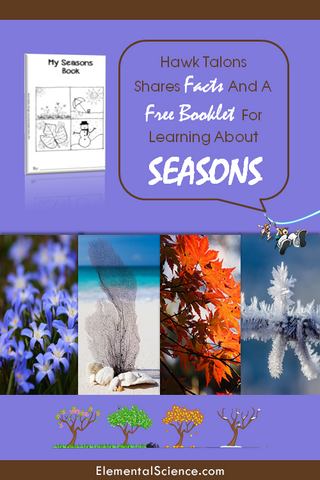FREE Shipping on all our products! (Please Note: Orders may experience a delay of a week or more in shipping due to the high volume of orders at this time of year.)
FREE Shipping on all our products! (Please Note: Orders may experience a delay of a week or more in shipping due to the high volume of orders at this time of year.)
Hawk Talons Shares Facts And A Free Booklet For Learning About Seasons
July 05, 2017 3 min read
It's awesome to watch the flowers and trees begin to bloom as the seasons' change. The scene outside changes from grey-brown colors to bright-green-rainbowy awesomeness.
Blaine and I have always appreciated the change of seasons. It's nice to have something different to look at. But to be honest we didn't really care why or how that happened.
That all changed one summer. The same summer we met Mr. Hawk Talons.
We won't spoil the whole adventure for you, but we did want to bring Mr. Talons here today to share a bit about the seasons with you all!
After he shares, we've got a super easy/fun booklet for you guys to try out, so be sure to stick around!
Let's get rolling...
The Seasons With Hawk Talons

As Blaine and Tracey know, I believe that knowing the science around us is key to our survival. As a survival expert, I have survived the extremes of the seasons all over the globe.
But what exactly is a season?
The dictionary defines a season as:
Each of the four divisions of the year (spring, summer, autumn, and winter) marked by particular weather patterns and daylight hours, resulting from the earth’s changing position with regard to the sun.
In short, a season is a collection of days with a typical weather pattern.
Seasons are a result of the changing position of the earth as it rotates around the sun. On earth, we have four seasons – spring, summer, autumn (or fall), and winter.
Typically, winter has shorter days of winter that can be filled with cold and snow. Around spring it warms and the flowers begin to bloom. During summer the days are longer and hotter. And finally, fall is marked by a drop in the temperature and a change in the leaves.
This all happens because the earth gets closer or farther away from the sun.
We mark beginning of a season with either an equinox or a solstice.
Equinox means “equal night” and it marks the point at which the time during the day equals the time during the night. Our year has two equinoxes, which serves to mark the beginning of spring and the start of fall.
Solstices occur when the sun is at its greatest distance from the earth. They mark the shortest day, which officially begins winter, and longest day of the year, which officially starts summer.
I trust that you all have a better understanding of seasons now. I'll close with what I always say when I share science with others:
Know the science of the earth. Know the science of survival.
A Seasons Book
Isn't Hawk great? He knows so much about the science of the earth and we learned a ton from our time in Patagonia with him.
Anywho, as promised here's a fun little booklet you can make with your kiddos about the seasons:
- Have the students make a “My Seasons Book” which explains what typically happens in the different seasons. Begin by writing the bold sentences below each on its own page. Then, have the students illustrate each page with the suggestions.
- Title Page: Did you know about the Seasons? (Have your students draw something related to one of the seasons.)
- Page 1: Did you know that in fall the leaves change color and fall off the trees? (Have your students draw a picture of a fall scene, ie. a tree with red, orange and yellow leaves.)
- Page 2: Did you know that in winter it gets very cold and snow falls from the sky? (Have your students draw a winter scene, ie. something that shows snow all over and a few snowflakes in the sky.)
- Page 3: Did you know that in the spring flowers begin to bloom and baby animals are born? (Have your students draw a spring scene, ie. a tree with flowers around it.)
- Page 4: Did you know that in summer it is very warm and it is time to go to the beach? (Have your students draw a summer scene, ie. a beach scene.)
- Page 5: I do! (Have your students draw a picture of themselves.)
- When they are done, staple the pages together to form a booklet.
Don't want to write all that out? Here's a free printable for you to use!
- Seasons Booklet Printable
Also in Homeschool Science Activities
Don’t Be Afraid To Try These 3 Christmas Tree Experiments Right Now
December 07, 2024 3 min read

It's the most wonderful time of the year and these three Christmas tree experiments will make your season even brighter! Click "Read More" to see them.
Steps For Dissecting A Seed By Felipe Moreno
November 09, 2024 2 min read

Felipe Moreno, one of the Sassafras twins' botany experts, shares an Argentinian folk ballad which shares the steps for dissecting a seed.
How to make a Beautiful Fall Leaf Book {A Fall Science Activity}
September 21, 2024 2 min read

Want to preserve the beauty of fall for science? Click "Read More" to learn how to make a fall leaf book and download the free templates!
Subscribe
Sign up to get the latest on sales, new releases and more …

